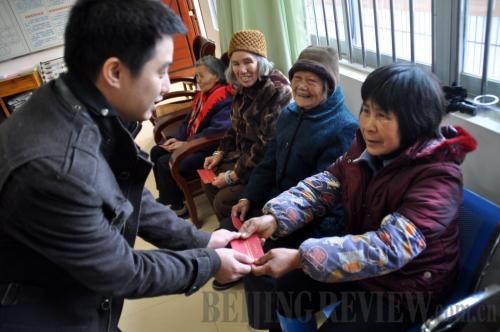|
 |
|
FULL COVERAGE: Local residents receive their pensions at a Social Security Center in Nanning, capital of Guangxi Zhuang Autonomous Region, on February 27. Since January 1, Guangxi's old-age social security system has realized full coverage (LU BOAN) |
China has taken the first step of diversifying investment tools for its pension funds. On March 20, the National Council for the Social Security Fund (NCSSF) said on its official website that it has been entrusted by south China's Guangdong Province to manage investment of its 100 billion yuan ($15.9 billion) pension fund for two years. This is the country's first attempt at investing pension funds in the capital market.
Liu Jingde, Deputy General Manager of the Research and Development Center of Cinda Securities Co. Ltd., said this is a good start for China to invest pension funds in the capital market. Other cities are expected to follow soon.
Yang Yansui, Director of the Research Center of Employment and Social Security at Tsinghua University, said one of the reasons for China to diversify pension fund investment is the current situation. By the end of 2010, the balance of pension funds in the world had totaled $31.1 trillion and that in the United States had hit $18.89 trillion yuan, accounting for 60 percent of the global total. The aging process in the United States started in 1960 and the peak will come in 2055. In comparison, China began the aging process in 2001 and the peak will come in 2037. The speed of China's aging process is much faster than that in the United States, forcing the country to maintain and increase the value of pension funds.
Ding Sanbao, chief accountant of the Social Security Fund Management Bureau of Guangdong Province, said they expect the returns of pension fund investment, after entrusting it to the NCSSF, will double the average in the past five years, or more than 4 percent.
In an announcement on March 21 the NCSSF also said Guangdong will get returns not lower than the interest of time deposits in the same time with the pension fund it entrusts to the NCSSF. At present, the interest rate for a two-year time deposit is 4.4 percent.
Guangdong has the biggest pension fund balance in China. In the first 11 months of 2011 alone, the province had an increased balance of 110 billion yuan ($17.49 billion) and the total balance reached 441.3 billion yuan ($70.16 billion). According to state laws, local pension funds can only be invested in time deposits or treasury bonds. Restricted by the investment channels, among the pension funds managed in Guangdong in 2010, 91.25 percent were invested in time deposits and 1.63 percent in bonds, with total returns of only 3.5 percent. In April of the same year the consumer price index (CPI) of the province rose by 5 percent. The investment returns rate of the social security fund is lower than the inflation rate, leading to actual depreciation of the pension fund. What is worse is that in the previous five years, the investment returns rate had been even lower—only 2 percent—far lower than the interest rate of one-year time deposits.
Hence, a 4-percent returns rate will be a big improvement for the pension fund of Guangdong Province.
In fact, low returns and depreciation of the yuan due to higher inflation rate are common in China. Pension funds in the country are managed by local governments. Zheng Bingwen, Director of the World Social Security Research Center at the Chinese Academy of Social Sciences, once estimated that the balance of pension funds in various localities of China totaled 1.9 trillion yuan ($302.07 billion), but the investment returns rate during the past decade was less than 2 percent, lower than the CPI growth during the same time and almost the lowest in the world.
Compared with the low returns of pension funds managed by local governments, the high investment returns of pension funds managed by the NCSSF is quite attractive. Beginning December 2006, the NCSSF was entrusted to manage 54.36 billion yuan ($8.64 billion) in individual accounts subsidized by the Central Government. Individual accounts are one of the components of China's pension fund system, which consists of social collected funds and individual accounts. The former, paid by employers, is equivalent to 20 percent of the employees' average monthly wage in the previous year, and the latter, paid in monthly installments by employees, equals 8 percent of their average monthly wage from the previous year.
By 2011 the investment returns rate of the NCSSF-managed fund reached 10.27 percent, nearly 8 percentage points higher than the inflation rate during the same period.
Given the present investment returns for the funds managed by the NCSSF, it will be easy to reach the goal of investment returns set by Guangdong Province.
The entrance of pension funds should have been good news for the capital market, but China's stock indices still continued to drop after this news.
| 